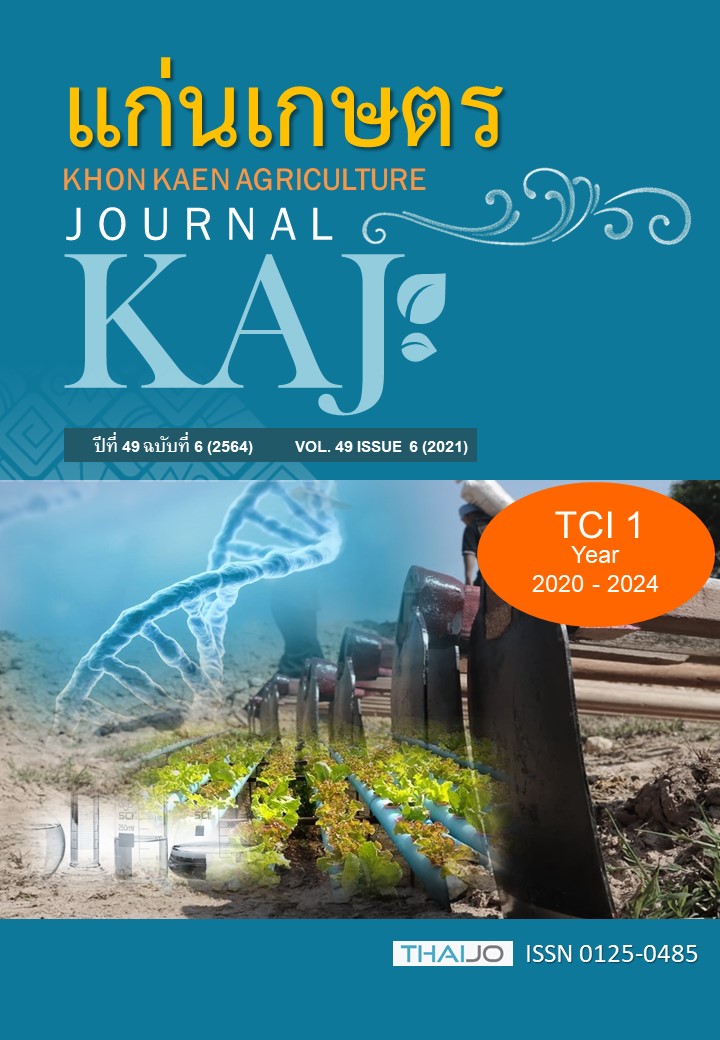อัตราการเจริญเติบโตของอ้อยภายใต้ความแห้งแล้งในช่วงต้นของการเจริญเติบโตในระบบการปลูกอ้อยข้ามแล้งภาคตะวันออกเฉียงเหนือ
Main Article Content
บทคัดย่อ
ภาคตะวันออกเฉียงเหนือของประเทศไทยนิยมปลูกอ้อยข้ามแล้งแบบอาศัยน้ำฝน ทำให้การผลิตอ้อยในภูมิภาคนี้เสี่ยงต่อการประสบความแห้งแล้งในช่วงต้นของการเจริญเติบโต ซึ่งส่งผลทำให้ผลผลิตอ้อยลดลงอย่างมาก ความเข้าใจอัตราการเจริญเติบโตของอ้อย (crop growth rate; CGR) ในแต่ละช่วงของการเจริญเติบโตอาจช่วยลดปัญหาความแห้งแล้งที่กระทบกับผลผลิตนี้ได้ ดังนั้น งานทดลองนี้จึงมีวัตถุประสงค์เพื่อศึกษา CGR ภายใต้การให้น้ำที่แตกต่างกันในระบบการปลูกอ้อยข้ามแล้ง โดยดำเนินงานทดลองในสภาพแปลง (field experiment) หมวดพืชไร่ คณะเกษตรศาสตร์ มหาวิทยาลัยขอนแก่น ใช้แผนการทดลองแบบ split plot in randomized complete block design จำนวน 3 ซ้ำ โดยกำหนดให้ main-plot คือ การให้น้ำที่ระดับความชื้นดิน 3 ระดับ (Field capacity (FC), ½ available water (AW) และ อาศัยน้ำฝน (rain-fed) ส่วน sub-plot กำหนดให้เป็น อ้อย 6 พันธุ์ ที่มีความทนแล้งและลักษณะรากที่แตกต่างกัน (KK3 , UT13, Kps01-12, KKU99-03, KKU99-02 และ UT12) เก็บข้อมูล มวลชีวภาพ และ CGR ที่อายุ 4 (ช่วงกระทบแล้ง) 6, 8, 10 (ช่วงฟื้นตัว) และ 12 เดือนหลังปลูก และเก็บผลผลิตอ้อยในช่วงอายุ 12 เดือนหลังปลูก พบว่า อ้อย 6 พันธุ์มีความแตกต่างกันทั้งในด้าน ผลผลิต มวลชีวภาพ และอัตราการเจริญเติบโต ซึ่งพันธุ์ KK3 และ UT13 เป็นพันธุ์ที่ให้ผลผลิตและมวลชีวภาพโดดเด่น ในสภาพขาดน้ำ (กรรมวิธีอาศัยน้ำฝน) มีอัตราการเจริญเติบโตสูงกว่าพันธุ์อื่น ๆ ทั้งในช่วงกระทบแล้งและในช่วงฟื้นตัว และการให้น้ำที่ระดับความชื้นดินที่ ½ AW พันธุ์อ้อยทั้ง 2 พันธุ์มีอัตราการเจริญเติบโตสูงกว่าพันธุ์อื่น ๆ ในช่วงฟื้นตัว นอกจากนี้ ผลผลิตของอ้อยที่อายุเก็บเกี่ยวมีความสัมพันธ์ทางบวกกับ CGR ในช่วง 4 เดือนหลังปลูก ในสภาพอาศัยน้ำฝน และผลผลิตมีความสัมพันธ์ทางบวกกับค่าเฉลี่ย CGR ในช่วงฟื้นตัว ทั้งใน 3 กรรมวิธีการให้น้ำ ดังนั้น พันธุ์อ้อยที่เหมาะสมในระบบการปลูกอ้อยข้ามแล้งในภาคตะวันออกเฉียงเหนือ ควรมีอัตราการเจริญเติบโตที่ดี ทั้งในช่วงที่กระทบแล้งในช่วงต้นของการเจริญเติบโตและในช่วงฟื้นตัว
Article Details

This work is licensed under a Creative Commons Attribution-NonCommercial-NoDerivatives 4.0 International License.
References
กอบเกียรติ ไพศาลเจริญ ทักษิณา ศันสยะวิชัย ศุภกาญจน์ ล้วนมณี ศรีสุดา ทิพยรักษ์ เกษม ชูสอน จินดา รัตน์ชื่นรุ่ง และชยันต์ ภักดีไทย. 2555. ความต้องการน้ำและค่าสัมประสิทธิ์การใช้น้ำของอ้อยพันธุ์ขอนแก่น 3. แก่นเกษตร. 40 (ฉบับพิเศษ 3): 103-114.
จิดาภา คงหินไธสง พัชริน ส่งศรี และนันทวุฒิ จงรั้งกลาง. 2560. รูปแบบการเจริญเติบโตและสรีรวิทยาของอ้อยต่อการจำลองความแห้งแล้งในระบบการปลูกอ้อยข้ามแล้ง. มหาวิทยาลัยนเรศวร: วิทยาศาสตร์และเทคโนโลยี. 25(2): 102-112.
สำนักงานคณะกรรมการอ้อยและน้ำตาลทราย. 2562. พื้นที่การปลูกอ้อย ปีการผลิต 2561/2562. แหล่งข้อมูล: http: //www.ocsb.go.th/th/home/index.php. ค้นเมื่อ 26 มกราคม 2564.
Abu-Ellail, F. F., A. F. I. Gadallah, and I. S. H. El-Gamal. 2020. Genetic variance and performance of five sugarcane varieties for physiological, yield and quality traits influenced by various harvest age. Journal of Plant Production. 11(5): 519-528.
Chumphu, S., N. Jongrungklang, and P. Songsri. 2019. Association of Physiological Responses and Root Distribution Patterns of Ratooning Ability and Yield of the Second Ratoon Cane in Sugarcane Elite. Agronomy. 9(4): 200.
Da Silva, J. A. 2017. The importance of the wild cane Saccharum spontaneum for bioenergy genetic breeding. Sugar Tech. 19(3): 229-240.
FAO.2016. Chapter 6 - ETcrop - Single crop coefficient (Kc). Available: http://www.fao.org/docrep/x0490e/x0490e0b.htm. Accessed January 21, 2021.
Jangpromma, N., P. Songsri, S. Thammasirirak, and P. Jaisil. 2010. Rapid assessment of chlorophyll content in sugarcane using a SPAD chlorophyll meter across different water stress conditions. Asian Journal of Plant Sciences. 9: 368-374.
Khonghintaisong, J., P. Songsri, and N. Jongrungklang. 2020. Root characteristics of individual tillers and the relationships with above-ground growth and dry matter accumulation in sugarcane. Pakistan Journal of Botany. 52(1): 101-109.
Khonghintaisong, J., P. Songsri, B. Toomsan, and N. Jongrungklang. 2018. Rooting and physiological trait responses to early drought stress of sugarcane cultivars. Sugar Tech. 20(4): 396-406.
Milligan, S.B., K.A. Gravois and F.A. Martin. 1990. Crop effects on broad-sense heritabilities and genetic variances of sugarcane yield components. Crop Science. 30: 344-349.
Nadeem, M., A. Tanveer, H. Sandhu, S. Javed, M.E. Safdar, M. Ibrahim, and U. Arshad. 2020. Agronomic and economic evaluation of autumn planted sugarcane under different planting patterns with lentil intercropping. Agronomy. 10(5): 644.
Olivier, F., and A. Singels. 2003. Water use efficiency of irrigated sugarcane as affected by row spacing and variety. Sugar Technology. 7: 347-351.
Otto, R., P. C. O. Trivelin, H. C. J. Franco, C. E. Faroni, and A. C. Vitti. 2009. Root system distribution of sugar cane as related to nitrogen fertilization, evaluated by two methods: monolith and probes. Revista Brasileira de Ciência do Solo. 33(3): 601-611.
Ramesh, P. 2000. Effect of different levels of drought during the formative phase on growth parameters and its relationship with dry matter accumulation in sugarcane. Journal of Agronomy and Crop Science. 185(2): 83-89.
Rao, P. G., and S. Singh. 1989. Relationship of growth characteristics with yield and quality in sugarcane (Saccharum officinarum L.). Indian Journal of Plant Physiology. 3: 206-211.
Robertson, M. J., N. G. Inman-Bamber, R. C. Muchow, and A. W. Wood. 1999. Physiology and productivity of sugarcane with early and mid-season water deficit. Field Crops Research. 64(3): 211-227.
Set-Tow, S., P. Songsri, and N. Jongrungklang. 2020. Variations in root distribution patterns and cane yield of 16 elite sugarcane clones grown under varied soil conditions. Sugar Tech. 22(6): 1018-1031.
Silva, P.P., L. Soares, J.G. Costa, L.S. Viana, J.C.F. Andrade, E.R. Goncalves, J.M. Santos, G.V.S. Barbosa, V.X. Nascimento, A.R. Todaro, A. Riffel, M.F. Grossi-de-Sa, M.H.P. Barbosa, A.E.G. Sant’Ana, and C.E.R. Neto. 2012. Path analysis for selection of drought tolerant sugarcane genotypes through physiological components. Industrial Crops and Products. 37: 11-19.
Songsri, P., S. Jogloy, C.C. Holbrook, T. Kesmala, N. Vorasoot, C. Akkasaeng, and A. Patanothai. 2009. Association of root, specific leaf area and SPAD chlorophyll meter reading to water use efficiency of peanut under different available soil water. Agricultural Water Management. 96(5): 790-798.
Sulistiono, W., Taryono, P. Yudono, and Irham. 2017. Growth analysis of transplanted sugarcane bud chips seedling in the dry land. International Journal of Scientific & Technology Research. 6(1): 87-93.
Turner, N. and M. Jones. 1980. Turgor maintenance by osmotic adjustment: A review and evaluation. P. 87–103. In: N.C. Turner and P.J. Kramer. Adaptation of Plants to Water and High Temperature Stress. John Wiley and Sons, NY. USA.
Uddin, S. M. M., S. Murayama, Y. Ishimine, E. Tsuzuki, and J. Harada. 1995. Studies on sugarcane cultivation: 2. Effects of the mixture of charcoal with pyroligneous acid on dry matter production and root growth of summer planted sugarcane (Saccharum officinarum L.). Japanese Journal of Crop Science. 64(4): 747-753.
Zhao, D., B. Glaz, and J.C. Comstock. 2010. Sugarcane response to water-deficit stress during early growth on organic and sand soils. American Journal of Agricultural and Biological Sciences. 5(3): 403-414.

